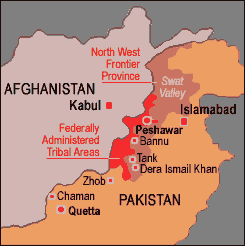Chachh
| Author:Laxman Burdak, IFS (R) |

Chach (Hindi: चच, Hindko and Urdu: چھچھ ) is a region located between Peshawar and Islamabad at the northern tip of Attock, consisting of an alluvial plain extending from Attock District of Punjab (Pakistan), southwest of Topi and Swabi.[1] Dr Stein has identified Chachh with Chuksha country of the Taxila copper inscription. [2]
Variants
Location
It is bounded on the north and west by the Indus river and is about 19 miles (31 km) long (from east to west) and 9 miles (14 km) broad. Percolation from the Indus makes the area extremely fertile.[3] The population of the area is primarily Hindko speakers. Chhachh is 7 km (4 mi) off the Pindi-Peshawar GT road. Chach is at the edge of Khyber Pakhtunkhwa-Punjab border. It is 20.4 km from Attock city and 22.9 km from Topi, Khyber Pakhtunkhwa.[4]
Chhachh is a plain which rolls from the Hazara-Gandhara hills south to Kamra, and from east of the River Indus to the broken lands near Lawrencepur.
Jat clans
History
The name "Chhachh" means A bowl type container according to the native language, which was used to drink lassi by the locals.[5] Geographically, the surface of the Chhachh region is like a bowl. Chhachh has been identified with the Chukhsa or Chuskha country of the Taxila copperplate inscription. In the Muslim period it was known as Chhachh-Hazara, or Takht Hazara. Hazro is in this plain.[6]
In 1001 AD Mahmud of Ghazni defeated Jay Pal and occupied the state of Bhatis, Bhatinda. He captured Multan and levied tax on acts of worship. Anand Pal, son of Jay Pal, took with him the rulers of Kannauj and Jujhauti and attacked Mahmud. In this war Gakkhar Jats were also with Anand Pal. Mahmud had come this time with a huge army and camped for 40 days. At last the army of Gakkhars attacked Mahmud at place called Chhachh near Atak. The Turk army could not sustain war before Gakkhars. Mahmud was about to withdraw from the war, But unfortunately at the same time the elephant of Anand Pal got angry, which sent the signals as a defeat and the army got demoralized. This led to the victory of Mahmud. (Dr Natthan Singh, 123-124)
The people
The majority of the population of Chhachh has Pathan, Pukhtoon/Pashtun roots and belongs to the Khaybar region (previously NWFP) or Afghan tribes who settled around this area, tribes that also include Qais Abdur Rashid.
There are of course various tribes who trace their roots back to other origins and the majority of families have overtime mixed in with other tribes, however the overwhelming majority of the people of Chhachh align, associate and identify themselves with the Pushtuns, and Hinko and Pukhto are the dominant languages of the area. The area of Chhachh is sandwiched between KPK and the Punjab, with Ghazi, Topi, Swabi in the north-east, Peshawar and Mardan region on the west, Wah, Taxila and Islamabad on the east, and Talagang to the south.
The people of this region are descendants of various tribes which include Durrani, Tanoli, Alizai, Yousafzai, Daudzai, Malizai, Kakar, Umarzai, Jadoon, Tareen, Tahirkheli, Sadozai, Khattak and Barakzai. They arrived in the area at around 1000 AD as part of the army of the Ghaznavid Empire and made it their permanent home after defeating the Hindu confederation near Hazro.[7]
Proof of this is that many of the villages and individual quarters are named after Pashtun personalities and tribes, markedly showing who had founded them. These include Nasozai, Musazai, Musakhel, Utman Khel, Saleem Khan, Ghorghushti, Shadi Khan and Barazai.
Awan, Sheikh, Mughal, Bhaakri, Bukhari and Gujjar are other main tribes of this region.
चुक्ष
विजयेन्द्र कुमार माथुर[8] ने लेख किया है ...चुक्ष (AS, p.340): तक्षशिला के एक अभिलेख में उल्लिखित स्थान, जिसका अभिज्ञान अटक (पाकिस्तान) के उत्तर में स्थित चच से किया गया है.
External links
References
- ↑ Peach, Ceri; Vertovec, Steven (2016-07-27). Islam in Europe: The Politics of Religion and Community. Springer. ISBN 9781349256976.
- ↑ Chach (Chhachch) - Imperial Gazetteer of India, v. 10, p. 115
- ↑ Chach (Chhachch) - Imperial Gazetteer of India, v. 10, p. 115
- ↑ Chach (Chhachch) - Imperial Gazetteer of India, v. 10, p. 115
- ↑ The Indian Antiquary, vol. xxv, pp. 174-5.
- ↑ Chach (Chhachch) - Imperial Gazetteer of India, v. 10, p. 115
- ↑ Shaw, Alison (2014-02-04). Kinship and Continuity: Pakistani Families in Britain. Routledge. ISBN 9781134434305.
- ↑ Aitihasik Sthanavali by Vijayendra Kumar Mathur, p.340
Back to Jat Places in Pakistan

